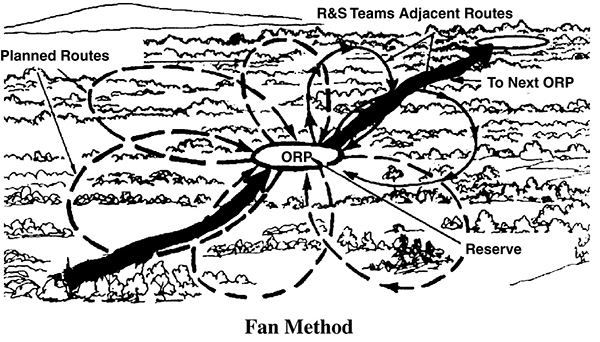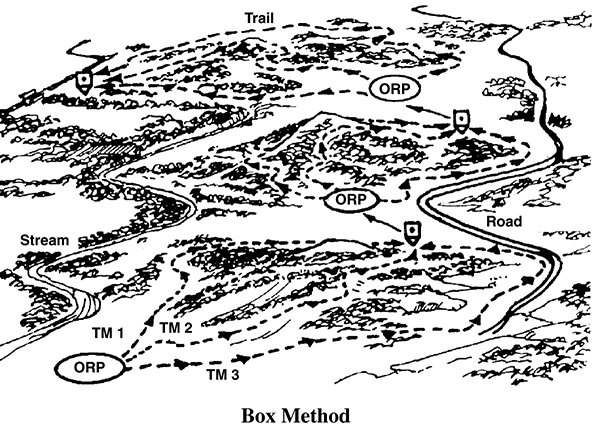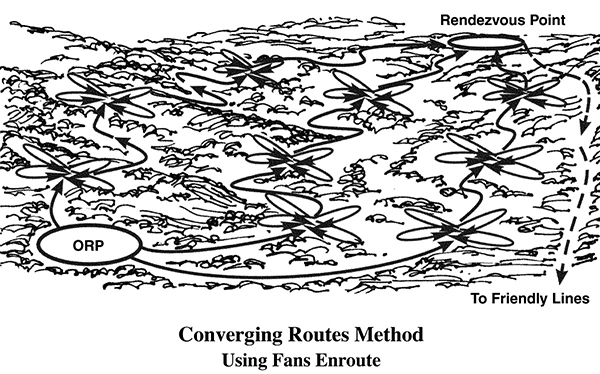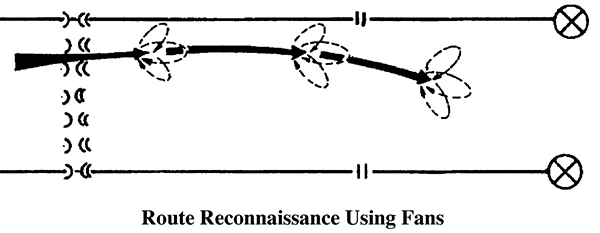Area Reconnaissance
An area reconnaissance is conducted to obtain information about a specified location and the area around it. The location may be given as a grid coordinate or as an objective on an overlay. In an area reconnaissance, the platoon or squad uses surveillance or vantage points around the objective to observe it and the surrounding area. After observing the objective for a specified time, all elements return to the ORP and report their observations to the leader or the recorder. Once all information is collected, it is disseminated to every soldier.
Zone Reconnaissance
A zone reconnaissance is conducted to obtain information on enemy, terrain, and routes within a specified zone. Zone reconnaissance techniques include the use of moving elements, stationary teams, or a series of area reconnaissance actions.
Moving Elements
The leader plans the use of squads or fire teams moving along multiple routes to cover the entire zone. Methods for planning the movement of multiple elements through a zone include the fan, the box, converging routes, and successive sectors.
Fan Method. The leader first selects a series of ORPs throughout the zone. The platoon establishes security at the first ORP. Each R&S team moves from the ORP along a different fan-shaped route that overlaps with others to ensure reconnaissance of the entire area. The leader maintains a reserve at the ORP. When all R&S teams have returned to the ORP, the platoon collects the information and disseminates it to every soldier before moving on to the next ORP.
Box Method. The leader sends his R&S teams from the ORP along routes that form a boxed-in area. He sends other teams along routes through the area within the box. All teams meet at a linkup point at the far side of the box from the ORP.
Converging Routes Method. The leader selects routes from the ORP through the zone to a linkup point at the far side of the zone from the ORP. Each R&S team moves along a specified route and uses the fan method to reconnoiter the area between routes. The leader designates a time for all teams to linkup.


Successive Sector Method. The leader divides the zone into a series of sectors. Within each sector, the platoon uses the converging routes method to reconnoiter to an intermediate linkup point, where it collects and disseminates the information gathered so far before reconnoitering the next sector.


Stationary Teams
Using this technique, the leader positions surveillance teams in locations where they can collectively observe the entire zone for long-term, continuous information gathering. He must consider sustainment requirements when developing his soldiers’ load plan.
Multiple Area Reconnaissance
The leader tasks each of his squads to conduct a series of area reconnaissance actions along a specified route.
Route Reconnaissance
A route reconnaissance is conducted to obtain detailed information about one route and all the adjacent terrain or to locate sites for emplacing obstacles. A route reconnaissance is oriented on a road, a narrow axis such as an infiltration lane, or a general direction of attack. Normally, engineers are attached to the infantry unit for a complete route reconnaissance. Infantry can conduct a hasty route reconnaissance without engineer support. A route reconnaissance results in detailed information about trafficability, enemy activity, NBC contamination, and aspects of adjacent terrain from both the enemy and the friendly viewpoint. In planning a route reconnaissance, the leader considers the following:
•The preferred method for conducting a route reconnaissance is the fan method described above. The leader must ensure that the fans are extensive enough to reconnoiter intersecting routes beyond direct-fire range of the main route.
•If all or part of the proposed route is a road, the leader must treat the road as a danger area. The platoon moves parallel to the road using a covered and concealed route. When required, R&S teams move close to the road to reconnoiter key areas.

COMBAT PATROL
Combat patrols are conducted to destroy or capture enemy soldiers or equipment; destroy installations, facilities, or key points; or harass enemy forces. They also provide security for larger units. The two types of combat patrol missions are ambush and raid.
Organization
Besides the common elements, combat patrols also have the following elements and teams:
Assault Element. The assault element seizes and secures the objective and protects special teams as they complete their assigned actions on the objective.
Security Element. The security element provides security at danger areas, secures the ORP, isolates the objective, and supports the withdrawal of the rest of the platoon once it completes its assigned actions on the objective.
Support Element. The support element provides direct-fire support and may control indirect fires for the platoon.
Breach Element. The breach element breaches the enemy’s obstacles when required.
Demolition Team/EOD. Demolition teams are responsible for preparing and exploding the charges to destroy equipment, vehicles, or facilities on the objective. They will also take control of any possible explosives on target.
Search Team/SSE. Sensitive site exploitation (SSE) teams can be made up from the assault element and may comprise two-man (buddy) teams or four-man search teams to investigate bunkers, buildings, or tunnels on the objective. These teams may search the objective or kill zone for casualties, documents, or equipment.
Leader’s Reconnaissance of the Objective
In a combat patrol, the leader has additional considerations when conducting his reconnaissance of the objective from the ORP. He is normally the assault element leader, and should also take the support element leader, the security element leader, and a surveillance team (a two-man team from the assault element) with him. The leader designates a release point halfway between the ORP and the objective. Squads and fire teams separate at the release point and move to their assigned positions. The platoon leader confirms the location of the objective and determines that it is suitable for the assault or ambush. He notes the terrain and identifies where he can place mines or Claymores to cover dead space. He notes any other features of the objective that may cause him to alter his plan.
If the objective is the kill zone for an ambush, the leader’s reconnaissance party should not cross the objective—doing so would leave tracks that might compromise the mission. The platoon leader confirms the suitability of the assault and support positions and routes from them back to the ORP. The platoon leader posts the surveillance team and issues a five-point contingency plan before returning to the ORP.
AMBUSH
An ambush is a surprise attack from a concealed position on a moving or temporarily halted target. Antiarmor ambushes are established when the mission is to destroy enemy armored or mechanized forces. Ambushes are classified by category (hasty or deliberate), type (point or area), and formation (linear or L-shaped). The leader uses a combination of all three classifications in developing his ambush plan. The key planning considerations include: